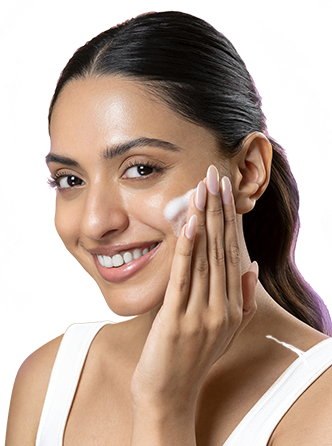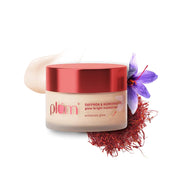
India is seriously well-endowed with sunshine. But human skin is not designed to take unlimited exposure to the sun. Darkening of skin is a known (and dreaded) consequence of sun exposure, but is that all you need to worry about? Does covering your face and arms with cloth and long gloves help prevent sun damage? We love busting myths, and chose our top 6 myths to bust.
Myth 1: I don't go out in the sun much, so I don't need to worry

Fact: What you really need to worry about are UV rays, not visible sunlight. UV rays are a bit crazy - they can penetrate clouds, and reflect off water, concrete and soil - in short, they can get you anywhere unless you are inside a nuclear-proof bunker. Therefore, excuses like "it's cloudy" and "i'm indoors" and "i avoid the sunlight" do not hold!
Myth 2: I cover my face and arms (ah! those long gloves) while outside, so I'm safe.

Fact: A typical white or light garment has an SPF of just around 7 or lower. Just not enough when you are out in the sun. Darker clothes have higher SPF, but then don't we prefer to wear lighter clothes in summer. If you want adequate protection from UV rays, we highly recommend choosing a good SPF cream.
Myth 3: Darkening of skin is the only thing I need to worry about. If my skin stays light, or if I'm already dark-skinned, I need not worry

Fact: Just like how a fever is the body's reaction to microbes, skin darkening is simply a reaction of the skin to sunlight. You have to attack the microbes, not the fever. Besides darkening, sun damage causes skin to look sagged and ageing (read why in our posts on
antioxidants and
green tea), hyper-
pigmentation aka dark spots, and in extreme cases, skin cancer. The
invisible damage from sun can be more dangerous than the
visible damage.
Myth 4: My fairness cream is all I need

Fact: That would be true if your fairness cream came with the right amount of SPF. No SPF = no protection from sun, as simple as that. So how much should be the SPF? See below.
Myth 5: The higher the SPF, the better protected I am

Fact: An SPF of 10, means that if your bare skin can withstand sun without getting damaged for 20 minutes, SPF 10 can increase it by 10 times, i.e., protect your skin for 200 minutes, or just over 3 hours. SPF 30 would mean 600 minutes, or 10 hours. Secondly, the amount of UV rays filtered by higher SPF does not increase beyond a point. See the table below for the extent of UV ray filtration by various levels of SPF:
| SPF |
% of UVB rays filtered |
| 15 |
93% |
| 30 |
97% |
| 50 |
98% |
| 100 |
99% |
Check out Plum's collection of SPF creams for different skin types
here. Yup, we cover the whole spectrum!
Myth 6: Yippee! I have SPF now. That's all I need.

Fact: Hold on. If you read the table above carefully, SPF is good to filter UVB rays. Without getting too technical, you need protection from both UVA and UVB. Look for ingredients like titanium dioxide, zinc oxide and avobenzone on the
ingredient list that can also give you protection from UVA rays.
You could check out Plum's bestselling high SPF & PA+++ sunscreen
here. That's both UVA & UVB protection.
Myths busted! Job done!
Until next time, make sure you fully understand and start following these safe sun practices. Questions? Do write in here: hello@plumgoodness.com
Related Products:
 Green Tea Day-Light Sunscreen Gel SPF35 | PA+++
Green Tea Day-Light Sunscreen Gel SPF35 | PA+++
 Bright Years All-Day Defence Cream SPF 45 | PA+++
Bright Years All-Day Defence Cream SPF 45 | PA+++
 Chamomile & White Tea Sheer Matte Day Cream SPF50 | PA+++
Chamomile & White Tea Sheer Matte Day Cream SPF50 | PA+++
 Grape Seed & Sea Buckthorn Light Stay Day Cream SPF 30
Grape Seed & Sea Buckthorn Light Stay Day Cream SPF 30
Related Posts:
5 at-home skincare tricks for the weekend
Can I remove sun tan at home? Yes you can
DIY: Glowing skin in 4 easy steps
Cool skincare tips for the summer







 Green Tea Day-Light Sunscreen Gel SPF35 | PA+++
Green Tea Day-Light Sunscreen Gel SPF35 | PA+++ Bright Years All-Day Defence Cream SPF 45 | PA+++
Bright Years All-Day Defence Cream SPF 45 | PA+++ Chamomile & White Tea Sheer Matte Day Cream SPF50 | PA+++
Chamomile & White Tea Sheer Matte Day Cream SPF50 | PA+++ Grape Seed & Sea Buckthorn Light Stay Day Cream SPF 30
Grape Seed & Sea Buckthorn Light Stay Day Cream SPF 30


















